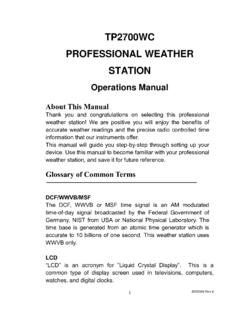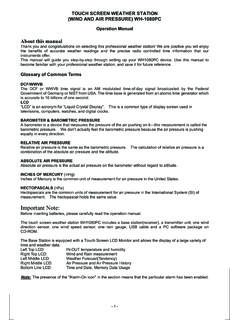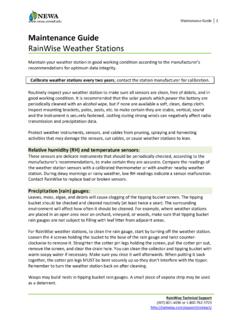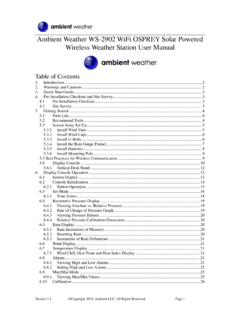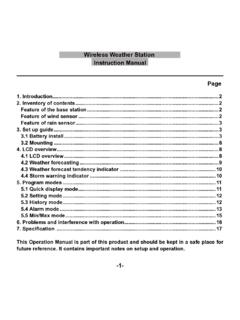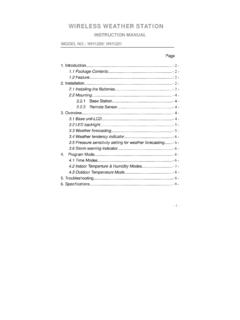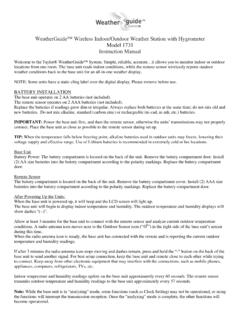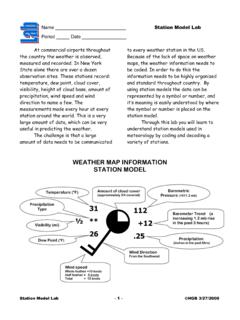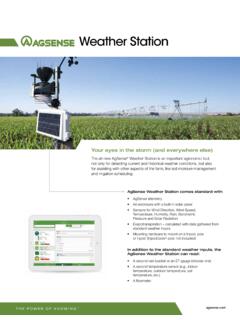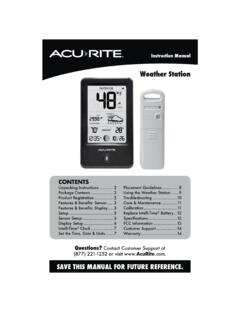Transcription of Wireless Weather Station - UPM Marketing
1 Wireless Weather StationWS2635 RSNUAOWNE MAL2 TABLE OF and date clock and humidity and humidity speed and gauge pressure pressure on your purchase of this UPM Wireless Weather Station WS2635. Please take the time to read and understand this manual, to enjoy the features and convenience of this is a Weather Station ?A Weather Station is a device that measures the current Weather conditions and transmits these readings from outdoor sensors to an indoor receiver. Then, based on these outdoor sensor readings, predicts the upcoming Weather forecast for the next 8-12 hours. The Weather forecast is displayed on the receiver as Weather icons, such symbols of the sun, clouds, rain or snow.
2 Remote transmitters:- Temperature transmitter (WT440H / Thermometer):The outdoor temperature sensor transmits an updated Wireless signal to the receiver every minute. The current temperature is then displayed on the receiver, in either Celsius or Fahrenheit. Additional temperature sensors may also be placed other locations (such as your greenhouse or wine cellar) to monitor temperature fluctuations in multiple locations. The receiver is compatible with up to three remote temperature transmitters, but only one is included in this Humidity transmitter (WT440H / Hygrometer):The concentration of water vapor in the air, at the location of the transmitter, is displayed as a relative humidity percentage ranging from 15% to 95%.
3 The ideal Comfort Zone for the human body ranges from 35 to 65% humidity, so long as the temperature remains between 18 and 24 Air Pressure (WS2635 / Barometer):A barometric pressure sensor is located within the receiver unit itself. The barometer monitors the atmospheric pressure, which is the amount of downward force exerted by the weight of the air, and is measured in inches of mercury (Hg). Air pressure fluctuations are an important factor in predicting changes in the Wind speed and direction gauge (WDS500 / Anemometer):The wind speed and direction is measured by the anemometer sensor, and this data is wirelessly transmitted to the receiver. The direction of the wind is displayed on a digital compass and the speed is given in km/h or Rain level gauge (RD700 / Pluviometer):The rainfall is measured and recorded by the rain gauge; it can be displayed in millimeters or in inches by the receiver.
4 The rain gauge gathers precipitation until its inner "tipping bucket" mechanism is full, then the bucket tips and the liquid is released. Every minute, the rain gauge calculates the number of times the bucket has tipped; then transmits this data to the receiver. The total accumulated rainfall (for the last hour, the present day, or for the previous day) may be REFERENCER eceiver layout - (refer to the diagram sheet)See diagram A1. MODE : to scroll through clock, alarm, altitude and temperature alarm (high & low) setting HOUR/+ : to view the rainfall history; adjust clock, alarm, date, altitude, year and temperature alarm MINUTE/ : to view the rainfall & wind speed, adjust the clock, alarm, date, altitude, year and temperature alarm CHN : to scroll through - local or remote channels 1, 2 or 3 (in high & low temperature alarm mode); to activate the learning procedure; to change the weekday setting in alarm mode; to toggle between C and F temperature : to activate the backlight (once activated, the backlight on will stay on for 6 seconds.)
5 ; to show Min and Max records; toggle between 12 and 24 hour format, to turn the alarm on and off; to disable (reset) high & low temperature alarms; to snooze the alarm; to set the altitude unit. 6. Wall-mount holder7. Tilted stand5 Receiver LCD display - (refer to the diagram sheet)See diagram B1. Rain fall records in mm/inches2. Wind speed in km/h or mph3. Wind direction4. Animated Weather forecast symbols5. Clock (HH:MM)6. Alarm on icon7. Radio controlled clock icon and time zone selection map8. Moon phase display9. Weekday10. Pressure historical graph11. Month/Day12. Pressure reading13. Pressure trend14. Outdoor temperature and humidity reading15. Outdoor temperature trend16. Indoor temperature and humidity reading17.
6 Indoor temperature trend6 DIAGRAM REFERENCE7 Temperature / Humidity remote sensor (WT440H)See diagram C1. SET: to enter house code and channel setting C/F: change between C or F temperature display, to adjust the channel and house code3. Remote channel number (1-3)4. Alternating outdoor temperature/humidity displayWind Gauge (Anemometer & Wind vane )See diagram D1. Wind vane2. Wind gauge s body and sensor3. Battery compartment4. Wind cups5. Mounting pole6. Wind gauge baseRain gauge (Pluviometer)See diagram E1. Base2. Sensor3. FunnelDIAGRAM REFERENCE8 TRANSMITTER SETUPB efore following the steps below, make sure you have the following items:- Compass (not included)- 9 x AA batteries (included)- 10 screws (included)Setting the wind gaugeThe wind gauge is a sensor that transmits the wind speed and the direction to the To install, (see diagram F)2.
7 There are 3 methods to mount the wind gauge (See diagram H). If you are installing the shaft in a horizontal position, remove the cap : 4 plugs are provided to screw the wind gauge s plate to a concrete or brick : Before mounting, you must use a compass to align the N marking on the plate of the wind gauge so that it is facing north (see diagram I). To see the North marking, you must temporarily remove the wind gauge fin. This step is necessary to indicate the correct wind Mounting the wind gauge (see diagram I)Note: Mount the wind gauge in an open space, as high as possible and without any nearby walls or obstacles, in the direct flow of the attatch the cups to the wind sensor body with the 3mm x 8mm make sure the top of the wind gauge is stable and To enure the most accurate readings, make sure that the wind cup and the fin are freely When the wind gauge's batteries are low, the following symbol will display on the receiver, under the wind speed display.
8 Setting the rain gauge sensorThe rain gauge is an individual sensor that transmits rainfall to the receiver andmeasures the total rainfall and precipitation To insert batteries into the rain gauge(see diagram G)2. To view possible locations to install the rain gauge. (See diagram H)3. To fasten the rain gauge with 2 screws (see diagram J)Note: The rain gauge gathers precipitation, until it's inner "tipping bucket" mechanism is full, then the bucket tips and the liquid is released. So place the unit in a location where the water can be safely released. To obtain accurate precipitation readings, there should be no obstacles (walls, trees, ) close to the rain gauge. When the rain gauge s batteries are low, the following indicator will display on the receiver under the rain fall display: Setting the temperature / humidity remote sensor1.
9 Remove the detachable cover at the back of the Use a screwdriver to open the battery door, located at the back of the Insert 2 AA batteries according to the indicated Close the battery compartment and re-insert the screw. The remote sensor will now display the outdoor temperature and humidity alternatively. 5. To toggle between C/ F temperature display, press the C/ F key. (Diagram C [2])TRANSMITTER SETUP10 INTERFERENCEI nterference occurs when radio waves or electronic signals are blocked or interrupted by consumer electronic products. In the case of a Weather Station , the signal from the transmitter to the receiver may be interrupted by a Wireless telephone, or other electronic equipment. Additionally, if your next door neighbor is operating a similar Weather Station , your receiver might pick up a signal fromtheir temperature sensor by mistake.
10 The solution to undesired interference is toset your temperature sensor(s) on a specific frequency (or house code) which ranges from 1-15. (This house code setting may be applied to the temperature/humidity transmitter (WT440H) only, not to the wind or rain gauges in this kit.)Setting the House CodeThe house code is the frequency signal sent by the remote sensor to thereceiver. If the receiver experiences signal interference, you will need to set the remote sensor to a different house code (default setting = 1).After inserting the batteries, the house code will flash for 8 seconds. Select a house code (1-15) by pressing C/ F (Diagram C [2]) and then press SET (Diagram C [1]). The remote sensors for each receiver must be set to the same house Channel for one or multiple sensorsThe WS2635 comes with only one temperature/humidity transmitter (WT440H)but it is compatible with up to three.

